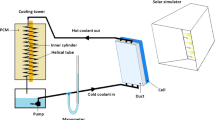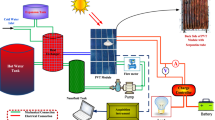Abstract
The main goal of the study is to increase the photovoltaic (PV) panel’s efficiency by applying the two-phase closed thermosyphon system having CuO nanofluid, which is a heat pipe-supported passive cooling method, to photovoltaic (PV) panels. For this purpose, in addition to the selected reference panel (PV1), five different passive cooling designs were performed, and experimental studies were carried out. In the first design, deionised water alone (PV2) and in the second design, passive cooling was applied by immersing the pure water heat pipes in deionised water (PV3). In the third, fourth and fifth designs, passive cooling was achieved by immersing 1 mass%, 2 mass% and 3 mass% (PV4, PV5 and PV6) CuO/pure water nanofluid heat pipes in deionised water, respectively. Experiments were conducted using a solar radiation source created with an incandescent lamp under laboratory conditions. The changes in the efficiency of the newly designed panels with five different passive cooling systems compared to the reference panel (PV1) were evaluated with both experimental results and theoretical calculations. As a result of these comparisons, it has been determined that passive cooling with heat pipes with CuO nanofluid is effective in increasing efficiency by decreasing the panel’s front surface temperatures. The panel’s front surface temperatures were 67.7 °C in PV1, while 55.2 °C, 51.8 °C, 51.4 °C, 51.7 °C and 50.9 °C in PV2, PV3, PV4, PV5 and PV6, respectively. Consequently, the highest increase in the efficiency of PV1 was realised in PV5 with approximately 7%.








Similar content being viewed by others
Abbreviations
- A :
-
Surface area (m2)
- back:
-
Back surface
- cm:
-
Centimetre
- CuO:
-
Copper oxide
- front:
-
Front surface
- hp :
-
Heat pipe
- I :
-
Radiation intensity (W m−2)
- Isc:
-
Short circuit current
- Imp:
-
Maximum power current
- in:
-
Incoming radiation
- kHz:
-
Kilohertz
- mm:
-
Millimetre
- N :
-
Number of measurements
- P :
-
Electrical power (W)
- Pmax:
-
Maximum power
- PV:
-
Photovoltaic
- PV/T:
-
Photovoltaic thermal
- Q :
-
Radiation energy (W)
- R :
-
Electrical resistance (ohm)
- S :
-
Standard deviation
- SDS:
-
Sodium dodecyl sulphate
- T :
-
Temperature (°C)
- TPCT:
-
Two-phase closed thermosyphon
- Ts :
-
Thermosyphon
- U :
-
Uncertainty
- V :
-
DC-Volt (V)
- Voc :
-
Open-circuit voltage
- Vmp :
-
Maximum power voltage
- w :
-
Water
- W:
-
Watt
- wt:
-
Mass
- X i :
-
Measurement values
- X m :
-
The arithmetic mean of measurement values
- α :
-
Sensibility
- η :
-
Efficiency
References
Babu C, Ponnambalam P. The role of thermoelectric generators in the hybrid PV/T systems: a review. Energy Convers Manag. 2017;151:368–85.
Dubey S, Sarvaiya JN, Seshadri B. Temperature dependent photovoltaic (PV) efficiency and its effect on PV production in the world a review. Energy Procedia. 2013;33:311–21.
Niźetić S, Grubiśić-Ćabo F, Marinić-Kragić I, Papadopoulos AM. Experimental and numerical investigation of a backside convective cooling mechanism on photovoltaic panels. Energy. 2016;111:211–25.
Ahmadi R, Monadinia F, Maleki M. Passive/active photovoltaic-thermal (PVT) system implementing infiltrated phase change material (PCM) in PS-CNT foam. Sol Energy Mater Sol Cells. 2021;222:110942.
Maleki A, Haghigi A, Assad MEH, Mahariq I, Nazari MA. A review on the approaches employed for cooling PV cells. Sol Energy. 2020;209:170–85.
Hammoumi AE, Chtita S, Motahhir S, Ghzizal AE. Solar PV energy: from material to use, and the most commonly used techniques to maximise the power output of PV systems: a focus on solar trackers and floating solar panels. Energy Rep. 2022;8:11992–2010.
Ramkiran B, Sundarabalan CK, Sudhakar K. Sustainable passive cooling strategy for PV module: a comparative analysis. Case Stud Therm Eng. 2021;27:101317.
Gang P, Huide F, Tao Z, Jie J. A numerical and experimental study on a heat pipe PV/T system. Sol Energy. 2011;85:911–21.
Chiang W, Permana I, Wang F, Chen H, Erdenebayar M. Experimental investigation for an innovative hybrid photovoltaic/thermal (PV/T) solar system. Energy Rep. 2022;8:910–8.
Wang G, Yang Y, Yu W, Wang T, Zhu T. Performance of an air-cooled photovoltaic/thermal system using micro heat pipe array. Appl Therm Eng. 2022;217:119184.
Yu M, Chen F, Zhou J, Yuan Y, Fan Y, Li Zhao X, Wang Z, Li J, Zheng S. Experimental investigation of a novel vertical loop-heat-pipe PV/T heat and power system under different height differences. Energy. 2022;254:124193.
Zhang T, Yan ZW, Xiao L, Fu HD, Pei G, Ji J. Experimental, study and design sensitivity analysis of a heat pipe photovoltaic/thermal system. Appl Therm Eng. 2019;162:114318.
Al-Waeli AHA, Chaichan MT, Kazem HA, Sopian K. Comparative study to use nano-(Al2O3, CuO, and SiC) with water to enhance photovoltaic thermal PV/T collectors. Energy Convers Manag. 2017;148:963–73.
Wang WW, Cai Y, Wang L, Liu CW, Zhao FY, Sheremet MA, Liu D. A two-phase closed thermosyphon operated with nanofluids for solar energy collectors: thermodynamic modeling and entropy generation analysis. Sol Energy. 2020;211:192–209.
Hoseinzadeh S, Sahebi SAR, Ghasemiasl R, Majidian AR. Experimental analysis to improving thermosyphon (TPCT) thermal efficiency using nanoparticles/based fluids (water). Eur Phys J Plus. 2017;132:197.
Moradgholi M, Nowee SM, Farzaneh A. Experimental study of using Al2O3/methanol nanofluid in a two-phase closed thermosyphon (TPCT) array as a novel photovoltaic/thermal system. Sol Energy. 2018;164:243–50.
Siecker J, Kusakana K, Numbi BP. A review of solar photovoltaic systems cooling technologies. Renew Sustain Energy Rev. 2017;79:192–203.
Murtadha TK, Hussein AA. Optimisation the performance of photovoltaic panels using aluminum-oxide nanofluid as cooling fluid at different concentrations and one-pass flow system. Results Eng. 2022;15:100541.
Ghadikolaei SSC. Solar photovoltaic cells performance improvement by cooling technology: an overall review. Int J Hydrog Energy. 2021;46:10939–72.
Gupta M, Singh Kumar R, Said Z. A review on thermophysical properties of nanofluids and heat transfer applications. Renew Sustain Energy Rev. 2017;74:638–70.
Al-Waeli AHA, Chaichan MT, Kazem HA, Sopian K. Evaluation and analysis of nanofluid and surfactant impact on photovoltaic-thermal systems. Case Stud Therm Eng. 2019;13:100392.
Sheikholeslami M, Gerdroodbary MB, Shafee A, Tlili I. Hybrid nanoparticles dispersion into water inside a porous wavy tank involving magnetic force. J Therm Anal Calorim. 2020;141:1993–9.
Nanografi nano technology. Copper-oxide physical and chemical properties. 2023. https://nanografi.com/nanoparticles/copper-oxide-cuo-nanopowder-nanoparticles-purity-99-5-size-77-nm/. [accessed 01 March 2023].
Lei J, Luo Z, Qing S, Huang X, Li F. Effect of surfactants on the stability, rheological properties, and thermal conductivity of Fe3O4 nanofluids. Powder Technol. 2022;399:117197.
Srimuang W, Amatachaya P. A review of the applications of heat pipe heat exchangers for heat recovery. Renew Sustain Energy Rev. 2012;16:4303–15.
Jafari D, Franco A, Filippeschi S, Marco PD. Two-phase closed thermosyphons: a review of studies and solar applications. Renew Sustain Energy Rev. 2016;53:575–93.
Özbaş E. A novel design of passive cooler for PV with PCM and two-phase closed thermosyphons. Sol Energy. 2022;245:19–24.
Ceylan İ, Yilmaz S, İnanç Ö, Ergün A, Gürel AE, Acar B, Aksu Aİ. Determination of the heat transfer coefficient of PV panels. Energy. 2019;175:978–85.
Ozbas E, Selimli S, Ozkaymak M, Frej ASS. Evaluation of internal structure modifications effect of two-phase closed thermosyphon on performance: an experimental study. Sol Energy. 2021;224:1326–32.
Ozbas E. Experimental study of thermal performance and pressure differences of different working fluids in two-phase closed thermosyphons using solar energy. J Polytech. 2019;22(1):121–8.
Author information
Authors and Affiliations
Corresponding author
Additional information
Publisher's Note
Springer Nature remains neutral with regard to jurisdictional claims in published maps and institutional affiliations.
Rights and permissions
Springer Nature or its licensor (e.g. a society or other partner) holds exclusive rights to this article under a publishing agreement with the author(s) or other rightsholder(s); author self-archiving of the accepted manuscript version of this article is solely governed by the terms of such publishing agreement and applicable law.
About this article
Cite this article
Acar, A., Namli, L. & Ozbas, E. An experimental investigation on passive cooling of the photovoltaic panel using CuO nanofluid in a two-phase closed thermosyphon. J Therm Anal Calorim 148, 9609–9618 (2023). https://doi.org/10.1007/s10973-023-12343-6
Received:
Accepted:
Published:
Issue Date:
DOI: https://doi.org/10.1007/s10973-023-12343-6




